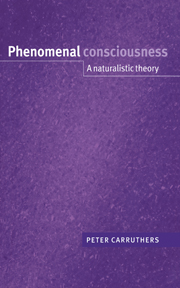Book contents
- Frontmatter
- Contents
- List of figures
- Preface
- 1 Assumptions, distinctions, and a map
- 2 Perspectival, subjective, and worldly facts
- 3 Explanatory gaps and qualia
- 4 Naturalisation and narrow content
- 5 First-order representationalism
- 6 Against first-order representationalism
- 7 Higher-order representationalism: a first defence
- 8 Dispositionalist higher-order thought theory (1): function
- 9 Dispositionalist higher-order thought theory (2): feel
- 10 Phenomenal consciousness and language
- 11 Fragmentary consciousness and the Cartesian theatre
- Conclusion
- References
- Author index
- Subject index
2 - Perspectival, subjective, and worldly facts
Published online by Cambridge University Press: 30 September 2009
- Frontmatter
- Contents
- List of figures
- Preface
- 1 Assumptions, distinctions, and a map
- 2 Perspectival, subjective, and worldly facts
- 3 Explanatory gaps and qualia
- 4 Naturalisation and narrow content
- 5 First-order representationalism
- 6 Against first-order representationalism
- 7 Higher-order representationalism: a first defence
- 8 Dispositionalist higher-order thought theory (1): function
- 9 Dispositionalist higher-order thought theory (2): feel
- 10 Phenomenal consciousness and language
- 11 Fragmentary consciousness and the Cartesian theatre
- Conclusion
- References
- Author index
- Subject index
Summary
Many have alleged that phenomenal consciousness can neither be accommodated within a physicalist world-view, nor reductively explained in physical terms. In this chapter I shall confront some of these ‘mysterian’ arguments, concentrating on those which are more metaphysical in nature. Then in the chapter which follows I shall deal with those which start from premises that are epistemic. If it is to be possible to provide a naturalistic explanation of phenomenal consciousness, as I intend, then all of these arguments must be flawed.
Perspectival and ‘myness’ facts
Nagel is often credited with putting the problem of phenomenal consciousness on the map. In this section I shall consider his main arguments. I shall show that they fail, and that their failure results from conflating notions which should be kept distinct.
What is it like to be a bat?
Nagel first asked this famous question in his 1974. His reply was that there must be an answer – there must be something which it is like to be a bat, resulting from the bat's distinctive way of experiencing the world through echo-location – but that we cannot know what it is. Nagel's view is that only someone who has had echo-location experiences, or experiences relevantly similar to those involved in echo-location, can know what it is like to be a bat.
- Type
- Chapter
- Information
- Phenomenal ConsciousnessA Naturalistic Theory, pp. 27 - 58Publisher: Cambridge University PressPrint publication year: 2000



